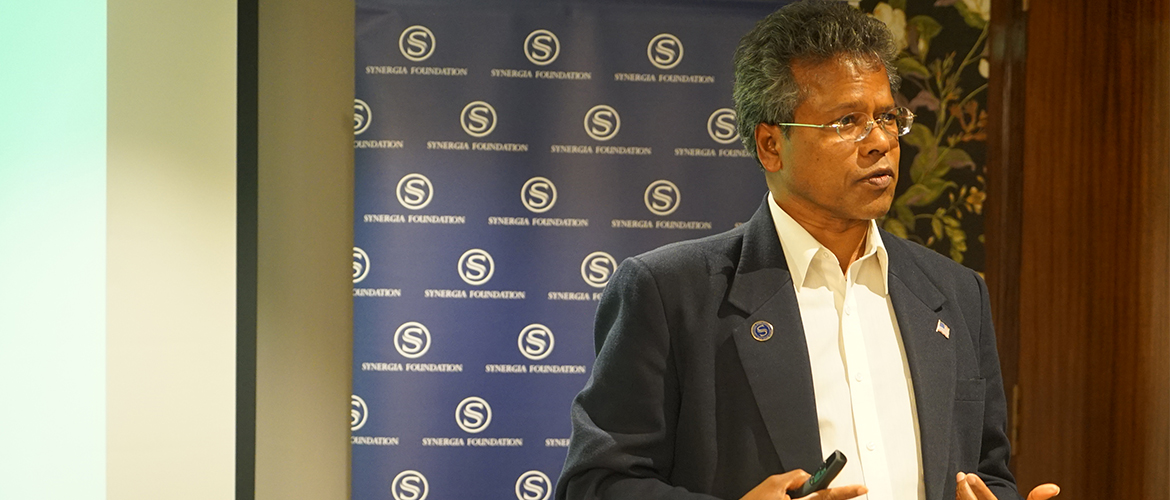The Humanitarian Silk Route
May 13, 2020 | Expert Insights
On March 21, a train loaded with 1,10,000 medical masks and 776 protective suites departed from Yiwu, in the east of China, for COVID-19-ravaged Spain, 17 days and 13,000 kilometres away. At the Synergia Webinar, Dr Mendis further expounded on how China's Belt and Road Initiative (BRI) has transformed itself from a transportation network to a Digital Silk Road and now a Health Silk Road.
These observations were part of a panel discussion during the 6th Synergia Webinar held jointly with the Taiwan Centre for Security Studies. The objective of the discussion was to review the coping strategies of South East Asian countries against COVID-19 and also analyse underlying priorities of China to recast the BRI into a 'Health Silk Road'.
The panel comprised of Dr Patrick Mendis (a former American diplomat and a military professor, who is currently serving as a Taiwan fellow of the Ministry of Foreign Affairs of The Republic of China); Fu-Kuo Liu (Research Fellow at the Institute of International Relations, National Chengchi University); Vinsensio Dugis (Senior Lecturer at the Department of International Relations, Airlangga University, Indonesia); and Mignonne Man-jung Chan (Chief Strategic Officer of the Humanities Forum as well as Healthy Asia), Major General Ajay Sah (retd.), along with the Synergia team's Sambratha Shetty (COO, Synergia Foundation), the moderator.
Projection of Chinese soft power
Dr Mendis, who specialises in the interpretation of Chinese objectives under the overhang of its past historical glories, said the Health Silk Road (HSR) dates back to 2017 when Chinese President Xi Jinping signed a memorandum of understanding with the World Health Organisation (WHO) for the construction of the HSR, with a promise of over of $30 million. The aim was to improve public health in countries along the Chinese belt.
Since the beginning of the pandemic, China had tried to turn the concept into reality through diplomatic engagement and despatch of medical aid. The aid provided to Italy was its major activity, which was given wide publicity. Even the China-based Alibaba Foundation donated PPE (personal protective equipment) and other medical supplies, not only to Europe but also to the U.S.
Dr Mendis regretted that the U.S., under President Trump, has relinquished its primacy as the world leader, especially in the time of a crisis. Mired in the compulsions of domestic politics in an election year, the U.S. is unable to come out with innovative counter-strategies. China, on the other hand, is displaying proactive leadership through it's already established HSR. Of course, there have been adverse reports of Chinese medical equipment not being up to standard.
In the post-COVID-19 scenario, China is likely to leverage the goodwill earned through its HSR for its commercial enterprises, like Lenovo and Huawei, who are now marketing ventilators and other medical electronics to members of the BRI in Europe.
According to Dr Mendis, this diplomatic heft would help China achieve its mission to become the most prosperous nation in the world by 2049. Of greater interest to India would be China's strong bilateral relations with South Asian countries and the willingness to open its purse strings in these desperate times.
COVID-19 preparations of S.E. nations
Compared to China and other S.E. Asian countries, the initial response of Taiwan was exemplary. Outlining the efforts made, Dr Fu-Kua Liu said the prompt closure of borders and a proactive medical action plan brought the virus under control early, restricting the spread to under 500 cases. Social distancing, isolation, tracing, etc., were all applied very early and proved successful.
Tensions in the South China Sea
The panel was unanimous in its opinion that despite the pandemic, tensions have remained high in the South China Sea, with Chinese forces indulging in aggressive manoeuvres against Vietnamese ships and other littoral countries. The overlapping EEZs (exclusive economic zones) are irritants, which despite the rulings of international bodies, are being interpreted by China in its own national interests. The presence of naval ships of the U.S, its ally Australia, and other countries such as Malaysia, have kept tensions high. According to Dr Fu-Kuo Liu, Taiwan currently is doing relatively well as they have now blocked its borders. China and Taiwan have managed better than most countries in the West.
Dr Vinsensio Dugis spoke about the new dynamics in global power, where there has been a shift in power from the West to the east, mainly China, which is being reflected in the incidents in the South China Sea. He also described the efforts of Indonesia to keep the virus at bay by imposing a lockdown and other social-distancing efforts.
There has been a decoupling of the supply chain by the epidemic, said Dr Mignonne Man-jung Chan. Globalisation changed everything, and the only thing that has been untouched is digital connectivity. The remaining geopolitical and economic activities have been made worse by the pandemic. The tensions between Taiwan and
China could worsen trade as they compete with each other on the supply of medical equipment. The need of the hour, he said, is to focus on solving the COVID-19 together, and then re-establish and survive in the global village.
Disrupted supply chains
When Major General Ajay Sah (retd.) pointed out the failure of China-centric supply chains during the pandemic, Dr Chan opined that all countries were free to create these supply chains, but the question was who could provide the best deal to the western companies. China was able to compete ahead of every other country and hence succeeded. In a post-COVID-19 scenario, if other countries like India are able to provide a more competitive field for global supply chains, then they would benefit.
Mr Tobby Simon pointed out that while countries in S.E. Asia benefited immensely from supply chains aligned to western markets, it is an irony that the West is now suffering from a disrupted global supply chain. How feasible would it be for a country like India, which has a population of over 1 billion, to build up its supply chains?
Dr Chan stated that while the trade disruption had a hard impact on China itself, instead of thinking of competition in supply chains, the time called for being more responsible.
A global supply chain is for everybody, not just one country. China now has been through a discussion on whether it should focus on domestic supply chains themselves. This re-thinking has been based on the principles of Tao and Confucianism. The western concept of competitive supply chains has overwhelmed all countries, including China and India, and it is not a sustainable feature.
The pandemic affords an opportunity for China to exercise its soft power in medical diplomacy and healthcare, along with propagating its role as an alternative to the U.S.So far, China has given $20 million to the WHO and has offered help to 82 countries.
Its initiatives on the Health and Digital Silk Road -- two offers that come along with trading with China -- opens up the possibilities of a more connected and global Asia.

A counterview
There are, however, some to whom China's COVID-19 aid seems to have a more intrusive bearing. Chinese supplies to countries like Spain, Italy, the Netherlands, and India, have turned out faulty by local standards. The masks have failed to protect the face or had defective filters. Severely-affected countries have termed Chinese supplies as "paltry" when compared to its massive manufacturing potential.
The world is unlikely to forget or forgive, China -- for its lack of transparency, the second time over (after the SARS epidemic), for delaying the acknowledgement of a new deadly virus amongst its citizens, and allowing its spread during the Lunar New Year exodus of the Chinese all over the globe; and its strong influence over the WHO, hesitant in undertaking independent investigations of the developing crisis and accepting, at face value, Chinese statements.



Comments